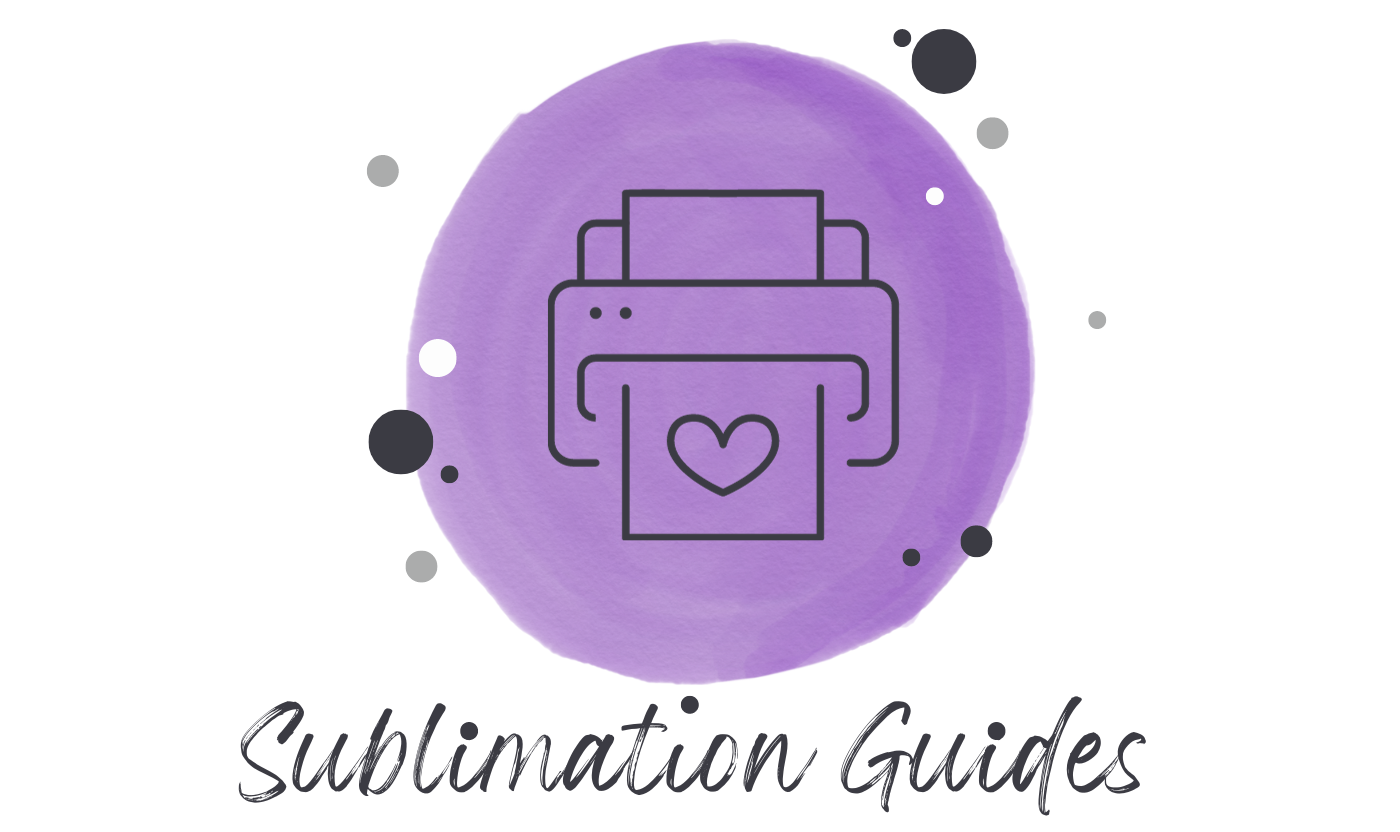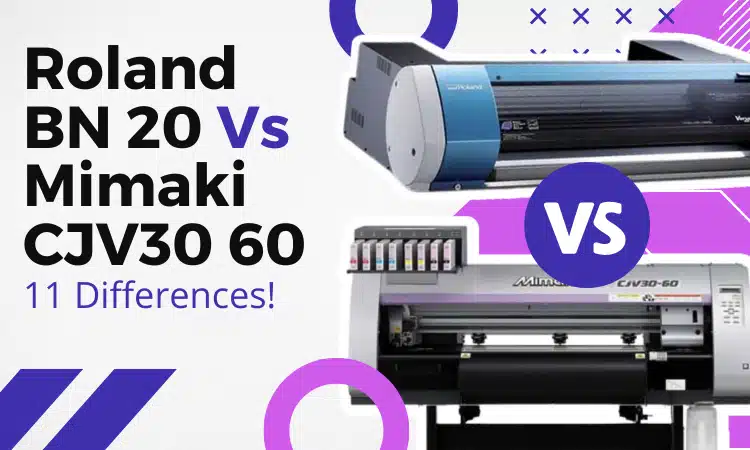Roland BN 20 and Mimaki CJV30 60 are considered alternatives due to their similar resolution and popularity. However, there are significant differences between them which you should consider before buying any one of these.
So, Roland BN 20 vs Mimaki CJV30 60 – which one should you choose?
The Mimaki CJV30 60 has a wider print/ cut and media width than the Roland BN 20. It also has a better-cutting force and rolls weight capacity compared to Ronald. However, unlike the BN 20, you can not print white-silver metallic colors in Mimaki CJV30-60. Also, Roland BN 20 is more expensive as it has better brand popularity. Furthermore, the Roland BN 20 can be accommodated in a smaller space.
To know these differences in detail, keep reading.
Contents
Roland BN 20 Vs Mimaki CJV30 60: Quick Comparison
Both printers claim to have similar print resolutions of a maximum of 1440 DPI. However, they have many differences which you have to consider before making the buying decision. Here’s a quick comparison between them.
| Features | Roland BN 20 | Mimaki CJV30 60 |
| Maximum print/cut width | 18.9″ | 24.0″ |
| Cutting speed | 0.4” to 5.9″ per second | 11.8″ per second |
| Cutting force | 30 to 300 gf (grams force) | 10-350 gf (grams force) |
| Media width range | 5.9″ to 20.3″ | 3.9” to 24.4″ |
| Maximum roll weight | 13.2 lbs. | 55 lbs. |
| Ink cartridges | Roland Eco-Sol MAX 220cc | Mimaki SS21, Mimaki ES3 ink |
| Ink Colors | 5 colors | 6 colors |
| Weight | 79.4 lbs. | 242 lbs. |
| Dimensions | 39.2″ x 23″ x 11.5″ | 60″ x 29.1″ x 56.0″ |
| Price | $6,750 to $6,800 | $3,700 to $3,750 |
| Warranty | 1 year | 2 years |
Roland BN 20 Vs Mimaki CJV30 60: In-depth Comparison

Here is an in-depth comparison between Roland BN 20 vs Mimaki CJV30 60. It will help you understand the factors better.
Maximum Print /Cut Width:
The Mimaki CJV30-60 has a wider printing width compared to the Roland BN-20. The Roland BN-20 has a maximum printing width of 18.9 inches, whereas, the Mimaki CJV30-60 has a maximum printing width of 24 inches.
The maximum print/cut width is the maximum size of media that can be used with the printer and cutter. So, in this case, The Mimaki CJV30-60 can handle larger print and cut jobs.
Winner: Mimaki CJV30-60
Cutting Speed:
The maximum cutting speed of the Roland BN 20 is 5.9″ per second, whereas, in Mimaki CJV30 60, it is 11.8″ per second. The maximum cutting speed refers to the fastest speed at which the printer’s cutting tool moves across the material being cut.
Mimaki CJV30-60 cuts almost twice as fast as the Roland BN-20, which makes it more efficient for longer-cutting jobs.
Winner: Mimaki CJV30-60
Cutting Force:
The Roland BN 20 can provide a cutting force of 30 to 300 gf while the Mimaki CJV30 60 can provide 10-350 gf of cutting force. So, with Mimaki CJV30 60, you can cut a wider range of materials compared to the Roland BN 20.
Winner: Mimaki CJV30 60
Media Width Range:
Roland BN 20 has a media width range of 5.9″ to 20.3″ and for the Mimaki CJV30 60, it is 3.9” to 24.4″. Media width range is the range of media sizes that a printer can handle. The Mimaki CJV30 60 can print a wider range of media than the Roland one. Both these printers have similar media thicknesses.
Winner: Mimaki CJV30 60
Maximum Roll Weight:
The maximum roll weight of Roland BN 20 is 13.2 lbs while the maximum roll weight in Mimaki CJV30 60 is 55 lbs. The maximum roll weight is the maximum weight of the media roll that a printer can handle.
The Mimaki CJV30-60 can handle more roll weight than Roland BN 20, which makes it more suitable for larger media rolls used in larger-scale applications.
Winner: Mimaki CJV30 60
Ink Cartridges:
In the Roland bn 20, you have to use only Roland Eco-Sol MAX 220cc ink cartridges while in CJV30-60, only Mimaki SS21, and Mimaki ES3 ink is allowed.
The Roland Eco-Sol MAX 220cc ink cartridges cost around $85 to $150. On the other hand, it will cost you around $150 to $300.
So, it looks like Roland bn 20 ink cartridges are more budget-friendly. Then again, in Mimaki cartridges, you are getting 440 ml of ink while the Roland Eco-Sol has 220 ml. So, the Mimaki will last longer.
Make sure to only use the recommended ink cartridges. Using different cartridges can cause problems in printing. For example, if you use the wrong cartridges, the sublimation can print blue instead of green.
Winner: Mimaki CJV30 60
Ink Colors:
The Roland BN 20 uses 5 colors while the Mimaki cjv30 60 uses 6 colors.
The 5-color configuration of Roland BN-20 uses a 5-color configuration including, cyan, black, yellow, magenta, and metallic silver or white. Due to the white or metallic ink, you can print metallic or white shiny prints on your printing media.
In contrast, the Mimaki CJV30-60 uses a 6-color configuration, including cyan, magenta, yellow, black, light cyan, and light magenta. However, with this printer, you can’t print metallic or shiny prints.
So, you must be thinking, what are light cyan and light magenta for?
The light cyan and light magenta colors help remove the dither dot appearance and the obvious halftone which occurs when you print only with CMYK configuration. So, with Mimaki CJV30 60, you will get a smoother color transition and better overall image quality.
Choosing the best sublimation paper will bring out the printing color quality even more.
Winner: Roland BN 20 for metallic and shiny prints.
Mimaki CJV30-60 for better image quality
Dimensions:
The Mimaki CJV30 60 is almost twice as big as the Roland BN 20. The dimension of the Roland BN 20 is 39.2″ x 23″ x 11.5″ which you can accommodate in smaller spaces.
On the other hand, the dimension of the Mimaki CJV30 60 is 60″ x 29.1″ x 56.0″ which is suitable for a spacious area.
Also, the Mimaki CJV30 60 printer is around three times heavier than the Roland BN 20. The Mimaki CJV30 60 is 242 lbs in weight while Roland BN 20 is only 79.4 lbs.
Winner: Roland BN 20
Price:
Although Roland BN 20 is far behind Mimaki CJV30 60 in the case of other features and capacity, it costs more than Mimaki. The Mimaki CJV30 60 costs around $3,700 to $3,750. On the other hand, the Roland BN costs around $6,750 to $6,800.
The price inconsistency can be a result of brand value. Roland is a more popular name in the graphics printer industry than Mimaki.
Winner: Mimaki CJV30 60
Warranty:
In the case of warranty, the Mimaki CJV30 60 is safer. Mimaki provides 2 years of warranty on this product. On the other hand, in Roland bn 20, you will get only one year of warranty.
If you are facing problems with the machine including the heat press tripping breaker problem, you can get free servicing during the warranty period.
Winner: Mimaki CJV30 60
Roland BN 20 Vs. Mimaki CJV30 60: Which One To Choose?
Mimaki CJV30 60 is better in terms of using a wider range of printing media and performing heavier printing jobs. You should choose this printer/cutter for better printing quality as well. It is also very budget-friendly.
However, if you are into brand value more, you will like Roland bn 20 better. Also, if you need to print shiny, metallic, and white prints, this one’s for you. If you have a smaller place to keep the printer, Roland BN 20 is a better choice.
FAQs
What Is The Fastest Roland Printer?
Soljet PRO4 XF-640 is the fastest printer manufactured by Roland. It has a maximum printing speed of 1,098 sqft./hr. It consumes a high amount of power as well, which is 1530 w during operation.
Is the Roland bn20 a DTF printer?
Yes, Roland BN20 is a DTF printer. With this printer, you can print designs directly onto a film that can be transferred onto t-shirts. This printer is compatible with various clothing materials including polyester, blended fabric, and cotton.
Where are Roland and Mimaki printers made?
The Ronald printers are made in Thailand, however, most of the components are imported from Japan. The Mimaki printers are made in Xuhui District, Shanghai, China.
Conclusion
Here goes my verdict on Roland BN 20 vs Mimaki cjv30 60. Hopefully, this will be enough to help you make a good decision.
Whatever graphic printer you choose, make sure to use only recommended media and ink cartridges with it. Otherwise, it’s not possible to get better-quality printing.
That’s all. Have a good day!

Emily loves making things special.
She’s also a mom and a wife who enjoys crafting and runs a small business from her home. She knows that the little things can make a house feel like a warm and loving home. This belief has led her to explore the exciting world of sublimation, a crafty way to add a personal touch to just about anything. Her website shares valuable information about sublimation, her crafty ideas, and tips.


